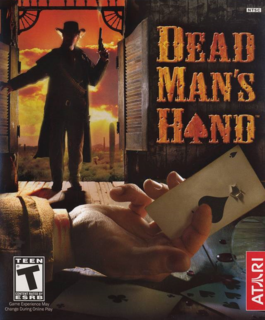A nostalgic visit to the amusement park shooting galleries of my youth...
That old, long-gone park attraction was the first thing that came to mind the moment I looked through El Tejón’s eyes. Every whiskey bottle, window pane, box, and barrel presents itself for a rampage of Yosimite Sam-like proportions. Blasting some items will occasionally lead to a gratifying chain reaction of destruction, and not even the buzzards flying overhead are safe. The real targets, of course, are the villainous cowboys and pistoleros who are loyal to the protagonist’s former peers, a group of sneering Old West archetypes who revoked El Tejón’s gang membership in grand fashion and left him for dead. The enemies are suitably detailed and competent with their own weapons (although their limited artificial intelligence tends to make them suicidally stationary), so the game doesn’t consist of just standing around shooting at inanimate objects. Doing so, however, lends power to El Tejón’s attacks through a shot meter which, once it is maxed-out, activates such features as a sniper scope and the Dillinger’s four-bullet combo.
The game’s detailed backgrounds of desert buttes, redwood forests, and mountains were expansive and attractive. Havoc’s ragdoll physics are always welcome in any game, and they’re especially effective in Dead Man’s Hand with the proper application of exploding barrels and collapsible balconies. However, I do have one MAJOR complaint (and this is directed toward any game developer): omitting the quicksave feature -- something to which we PC gamers, in particular, are very accustomed -- is just not cool. Starting over entirely from the beginning of a level does not constitute a challenge, it’s a direct line to jaw-grinding frustration coupled with a bout of vengeful software uninstallation.
Notable Feature: The shot meter. Including it wasn’t terribly essential, but the power enhancements that the meter activates provide an excuse to blast everything in sight to pieces.
Favorite Weapon: I got a lot of mileage out of the Pepperbox pistol. Its fast firing rate makes for easy trick shots even at long range and the secondary mode is useful for a quick ambush from behind cover.
Favorite Level: The very last battle, which takes place (minor spoiler alert) amidst the wreckage of several train cars at the edge of a massive and well-rendered desert.
Dead Man’s Hand does a very good job of satisfying my love of virtual breakage. The game’s variety in its sound effects, environmental details, and character textures outweighs the minimal story and conspicuously absent quicksave function. Aside from the latter problem, the tale of El Tejón’s redemption made for an entertaining diversion.

